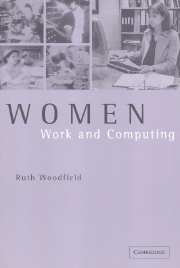Book contents
- Frontmatter
- Contents
- Preface
- List of abbreviations
- 1 The myth of the neutral computer
- 2 Computers, communication and change
- 3 Softech: a ‘twenty-first-century organisation’
- 4 Male and female pathways through the unit
- 5 Hybrids and hierarchies
- 6 Understanding the relationship between gender and skill
- 7 The female future and new subjectivities
- Conclusion: is the future female?
- List of references
- Index
7 - The female future and new subjectivities
Published online by Cambridge University Press: 22 September 2009
- Frontmatter
- Contents
- Preface
- List of abbreviations
- 1 The myth of the neutral computer
- 2 Computers, communication and change
- 3 Softech: a ‘twenty-first-century organisation’
- 4 Male and female pathways through the unit
- 5 Hybrids and hierarchies
- 6 Understanding the relationship between gender and skill
- 7 The female future and new subjectivities
- Conclusion: is the future female?
- List of references
- Index
Summary
Introduction
The assumption underpinning the third wave of optimism was that the process of computing may fundamentally challenge the common-sense universe that perceives male and female bodies differently, and via this challenge precipitate a genderless future. The suggestion is that computing may disembody and dislocate us socially and psychologically so that we may understand our relationship to our own body in a new way, one that does not recognise the limitations physicality imposes upon us. It is also suggested that we may begin to see others very differently, may break with the historical connections we have made between perceived communication or behaviour, and the physical embodiment of the communicator or actor.
The computer is thought to provoke modern consciousness into these novel ways of thinking about itself through a variety of means. It provides a screen upon which we can project images of ourselves, through which we can renegotiate ‘old boundaries’ between nature and culture, reason and emotion, mind and body, animate and inanimate, active and passive, self and other, and through which we can rethink the parameters of our potentialities and limitations in the process (Turkle 1996: 22). The computer therefore causes us to question the status quo and the fixity of human nature and becomes the foundation of ‘new cultural forms’ (166).
As well as this indirect manner of provoking conceptual change, the computer is also assumed by advocates of this wave to more directly provoke transformations in consciousness.
- Type
- Chapter
- Information
- Women, Work and Computing , pp. 173 - 185Publisher: Cambridge University PressPrint publication year: 2000



